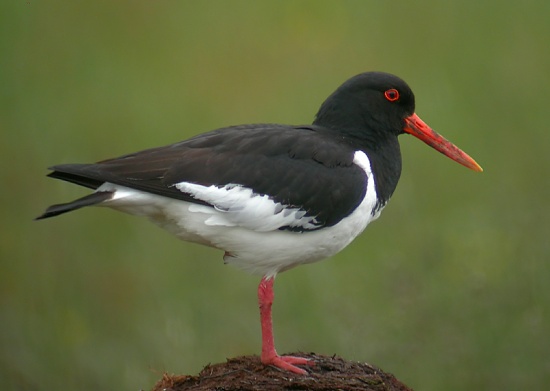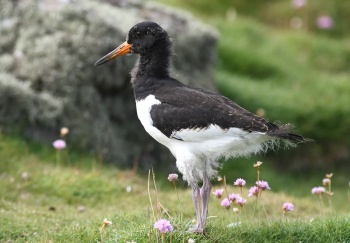(Immature and flight photos. Distribution & Behaviour expanded.) |
|||
| Line 1: | Line 1: | ||
| − | [[Image:Eurasian_Oystercatcher.jpg|thumb|550px|right|Photo by {{user|jenygard|jenygard}}]] | + | [[Image:Eurasian_Oystercatcher.jpg|thumb|550px|right|Photo by {{user|jenygard|jenygard}}<br />Runde, [[Norway]], June 2003]] |
;[[:Category:Haematopus|Haematopus]] ostralegus | ;[[:Category:Haematopus|Haematopus]] ostralegus | ||
| Line 10: | Line 10: | ||
*Juvenile - brown with white neck band and dull bill. | *Juvenile - brown with white neck band and dull bill. | ||
==Distribution== | ==Distribution== | ||
| − | [[ | + | [[Image:Skomer-080710 IMG 0148.jpg|thumb|350px|right|Immature<br />Photo by {{user|beverley|beverley}}<br />[[Skomer]] Island, [[Wales]], July 2010]] |
| + | Widespread throughout [[Eurasia]] and [[Africa]]. | ||
| + | Rare migrant on [[Greenland]]. Accidental vagrant to [[Newfoundland]] (several records). | ||
==Taxonomy== | ==Taxonomy== | ||
====Subspecies==== | ====Subspecies==== | ||
| + | There are 3 subspecies<sup>[[#References|[1]]]</sup>: | ||
*''H. o. ostralegus'' - [[Iceland]] and [[Scandinavia]] to south [[Europe]]; winters to [[Africa]] | *''H. o. ostralegus'' - [[Iceland]] and [[Scandinavia]] to south [[Europe]]; winters to [[Africa]] | ||
*''H. o. longipes'' - [[Russia]] to [[Siberia]] and south to Caspian Sea and Aral Sea | *''H. o. longipes'' - [[Russia]] to [[Siberia]] and south to Caspian Sea and Aral Sea | ||
| Line 20: | Line 23: | ||
Beaches and coast in winter. Breeds in upload grassy areas. | Beaches and coast in winter. Breeds in upload grassy areas. | ||
==Behaviour== | ==Behaviour== | ||
| + | [[Image:Oystercatcher - Haematopus ostralegus sun.jpg|thumb|350px|right|Photo by {{user|Reels|Reels}}<br />Edinburgh, [[Scotland]], 2010]] | ||
| + | ====Diet==== | ||
The diet includes molluscs, mussels and earthworms. | The diet includes molluscs, mussels and earthworms. | ||
| + | ====Breeding==== | ||
| + | They nest in a scrape on pebbles which may be on the coast, riverside or in grassy fields and even upland moors. The clutch consists of 2-4 eggs which are coloured buff to yellow possibly with a greenish tint; there are variable markings of streaks and spots from greyish to black. | ||
| − | + | There is a single clutch, usually in May. | |
====Vocalisation==== | ====Vocalisation==== | ||
<flashmp3>Haematopus ostralegus (song).mp3</flashmp3><br /> | <flashmp3>Haematopus ostralegus (song).mp3</flashmp3><br /> | ||
''[[Media:Haematopus ostralegus (song).mp3|Listen in an external program]]'' | ''[[Media:Haematopus ostralegus (song).mp3|Listen in an external program]]'' | ||
==References== | ==References== | ||
| − | Wikipedia | + | #{{Ref-Clements6thOct12}}#Wikipedia |
| + | #Observers Book of Birds Eggs | ||
| + | {{ref}} | ||
==External Links== | ==External Links== | ||
{{GSearch|Haematopus+ostralegus}} | {{GSearch|Haematopus+ostralegus}} | ||
Revision as of 22:10, 26 March 2013
- Haematopus ostralegus
Identification
- Black above
- White below
- White wing and tail patches
- Red legs
- Strong broad red bill
- Juvenile - brown with white neck band and dull bill.
Distribution
Widespread throughout Eurasia and Africa.
Rare migrant on Greenland. Accidental vagrant to Newfoundland (several records).
Taxonomy
Subspecies
There are 3 subspecies[1]:
- H. o. ostralegus - Iceland and Scandinavia to south Europe; winters to Africa
- H. o. longipes - Russia to Siberia and south to Caspian Sea and Aral Sea
- H. o. osculans - Kamchatka Peninsula and North Korea; winters east China
Habitat
Beaches and coast in winter. Breeds in upload grassy areas.
Behaviour
Diet
The diet includes molluscs, mussels and earthworms.
Breeding
They nest in a scrape on pebbles which may be on the coast, riverside or in grassy fields and even upland moors. The clutch consists of 2-4 eggs which are coloured buff to yellow possibly with a greenish tint; there are variable markings of streaks and spots from greyish to black.
There is a single clutch, usually in May.
Vocalisation
<flashmp3>Haematopus ostralegus (song).mp3</flashmp3>
Listen in an external program
References
- Clements, J. F., T. S. Schulenberg, M. J. Iliff, B.L. Sullivan, C. L. Wood, and D. Roberson. 2012. The eBird/Clements Checklist of Birds of the World. 6th ed., with updates to October 2012. Ithaca: Cornell Univ. Press. ISBN 978-0801445019. Spreadsheet available at http://www.birds.cornell.edu/clementschecklist/downloadable-clements-checklist
- Wikipedia
- Observers Book of Birds Eggs
Recommended Citation
- BirdForum Opus contributors. (2024) Eurasian Oystercatcher. In: BirdForum, the forum for wild birds and birding. Retrieved 7 May 2024 from https://www.birdforum.net/opus/Eurasian_Oystercatcher
External Links






